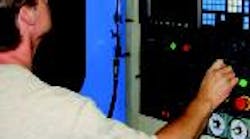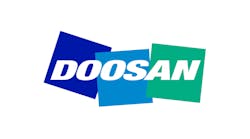CNC machinist Dale Christensen loads program to an 800mm HMC.
"In the last seven years we have invested a lot of money in new machines," says Craig Lewandowski, vice president of manufacturing for E.H. Wachs Company. "But, it has been our employees that have made us so successful.
"The most expensive machining center will only be as good as the person operating it and it took us a while to learn that lesson. We had to get the mindset that our employees are as big an asset as that machining center sitting over there and we had to go through a lot of people before we realized that."
Seven years ago, Wachs was operating with old and often limited capability equipment. Employee turnover was high because operators were expected to produce ever more complex parts in ever increasing quantities on the outdated equipment. At the same time sales demand began to explode so the company decided to retool.
Today, all but two of the production machines are new and those two will be replaced this year. With the new equipment came higher productivity, higher profits, lower turnover and greater employee involvement in deciding how work gets done.
"We try to empower our people," said Lewandowski. "We encourage them to point out problems and suggest solutions. When they do we respond quickly and positively. We're not interested in finding fault, we're interested in quickly spotting problems and then finding solutions. We have become very quick and dynamic in dealing with production problems." If an operator has a problem running a part he can stop production and get his supervisor, the manufacturing engineer and even the design engineer quickly involved in figuring out how to best solve the problem.
Along with the retooling has come a commitment to continuous improvement.
Because lot sizes are small—usually less than 60 pieces in a run— automation opportunities are limited at Wachs, so they focus on improving workflow. The shop added a second manufacturing engineer to enable it to look at production areas that were troublesome and to figure out how to improve those processes.
As Wachs comes up with new products they solicit input and ideas from everyone who will touch those parts on ways to do the work better. Wachs also split production supervision into two areas - the machine shop and everything else. This spreading of the work load has enabled the machine shop supervisor to have time to find more ways to improve production. The shop also formed a group to plan and schedule production and to provide rescheduling based on changing sales orders.
Wachs started making steam boilers and piping in 1883, and has become a global supplier of on-site machining equipment for cutting pipe and tubing. All machining is done in-house except gear cutting and laser heat treating. There are 35 people in machining and assembly on the day shift, and 12 in machining on the night shift.
While most of their machining is on standard products, they are sometimes called on to create parts used in special applications such as demolishing oil wells in the Gulf of Mexico that were destroyed by Hurricane Katrina and cutting a submarine in half so that its reactor core could be replaced.
"We have to get everyone involved in thinking about better ways to work," said Lewandowski, "because you never know where the next great idea is going to come from."
| E.H.Wachs Company Lincolnshire, Illinois www.wachsco.com |


